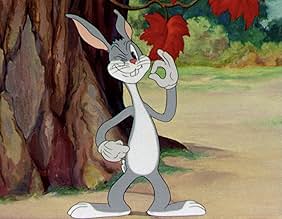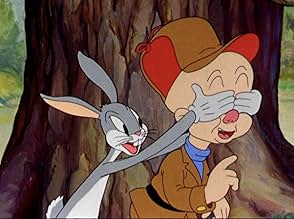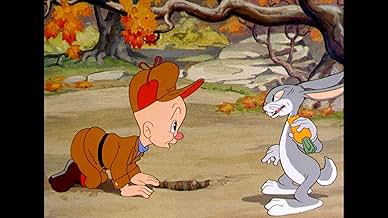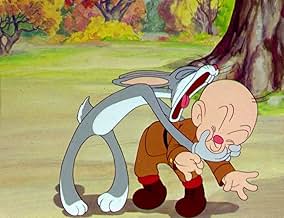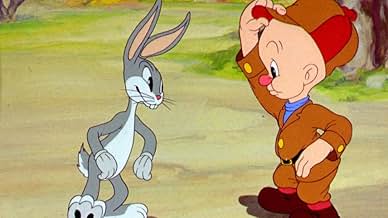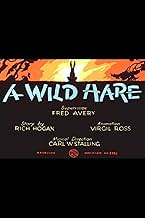Ajouter une intrigue dans votre langueWhile hunting rabbits, Elmer Fudd comes across Bugs Bunny, who tricks and harasses the hunter.While hunting rabbits, Elmer Fudd comes across Bugs Bunny, who tricks and harasses the hunter.While hunting rabbits, Elmer Fudd comes across Bugs Bunny, who tricks and harasses the hunter.
- Réalisation
- Scénario
- Casting principal
- Nommé pour 1 Oscar
- 2 nominations au total
Mel Blanc
- Bugs Bunny
- (voix)
- (non crédité)
- …
Arthur Q. Bryan
- Elmer Fudd
- (voix)
- (non crédité)
Avis à la une
Here is Tex Avery's magnificent film in which we are first introduced to a brownish-gray colored hare named Bugs, although we really don't hear his name spoken in this film. Yet that immortal phrase, "What's Up Doc???" is here, and Bugs is a sly, bold, incredibly smart woodland creature outfoxing that "wovable" hunter, Elmer Fudd. No more wacky prototypes. Bugs is at last fleshed out the way he should be. I appreciate his "Dad" and "Grandpa" very much. Someone's dream wouldn't have come true without them and our star might never have been born without them. Nevertheless, the star is Bugs Bunny!!! And after this film, he was well on his way to becoming what he is today.
Thank you Tex Avery!!!
Thank you Tex Avery!!!
It is very hard to review "A Wild Hare" on its own solo merit after the sixty-plus years that followed and thus turned its central character into the biggest cartoon character ever. In comparison to the subsequent films that appeared until 1964, this very first official entry is tame but still a wonderful model for those that followed.
Let's say this was 1940 and If I saw this cartoon for the first time ever with absolutely no knowledge of Bugs Bunny, I would say that "A Wild Hare" alone is a fine cartoon, in which the hunter becomes the heckled. The prey is a slick "wabbit" character that starts in on him at the very beginning, knocking on the wisping hunter's bald head to get his attention.
It is no wonder that this cartoon is directed by Fred Avery, who only three years ago directed a similar cartoon called "Porky's Duck Hunt," in which Porky's prey evolved into the current Looney Tunes star Daffy Duck. Should we be keeping our eyes on this "wabbit?"
Let's say this was 1940 and If I saw this cartoon for the first time ever with absolutely no knowledge of Bugs Bunny, I would say that "A Wild Hare" alone is a fine cartoon, in which the hunter becomes the heckled. The prey is a slick "wabbit" character that starts in on him at the very beginning, knocking on the wisping hunter's bald head to get his attention.
It is no wonder that this cartoon is directed by Fred Avery, who only three years ago directed a similar cartoon called "Porky's Duck Hunt," in which Porky's prey evolved into the current Looney Tunes star Daffy Duck. Should we be keeping our eyes on this "wabbit?"
Compared to the first (two) appearances of the developing Bugs, this is very funny, has characters with incredibly developed plots and indeed is better quality. I find because the humour of "Porky's Hare Hunt" and "Prest-O Change-O" are very old-fashioned and not very understandable for today's humour (although I still found "Porky's Hare Hunt" quite funny). This episode feels much more like it was made recently, even though it was made only two or three years after the developing Bug's first appearances. In this, apart from his deeper voice, he feels much more like the Bugs Bunny we know today.
I also like this episode for the very sweet first Elmer featured, Bugs Bunny is very entertaining and there is nice animation included. I have to say in this, Bugs Bunny reminded me a lot of Br'er Rabbit, which was comforting (HE didn't make his first appearance for nearly ten years after!!).
The plot is very much like the average episode with Elmer and Bugs. Elmer is hunting for "wabbits" and he finds Bugs. Many of the gags have been repeated many times in more recent episodes, but are still funny none the less. There are some other gags added which are funny.
I recommend this episode to enthusiasts of early Looney Tunes (but still like gags which are repeated in modern Looney Tunes episodes) and who like Bugs Bunny. Enjoy "A Wild Hare"!
I also like this episode for the very sweet first Elmer featured, Bugs Bunny is very entertaining and there is nice animation included. I have to say in this, Bugs Bunny reminded me a lot of Br'er Rabbit, which was comforting (HE didn't make his first appearance for nearly ten years after!!).
The plot is very much like the average episode with Elmer and Bugs. Elmer is hunting for "wabbits" and he finds Bugs. Many of the gags have been repeated many times in more recent episodes, but are still funny none the less. There are some other gags added which are funny.
I recommend this episode to enthusiasts of early Looney Tunes (but still like gags which are repeated in modern Looney Tunes episodes) and who like Bugs Bunny. Enjoy "A Wild Hare"!
A Wild Hare (1940)
*** 1/2 (out of 4)
This is where it all started as the dimwitted Elmer Fudd travels to the woods hunting rabbit and comes across Bugs Bunny who is just too smart. A WILD HARE was actually the third film that Bugs appeared in but this here is the official first as the rabbit we all love. It's funny watching this first short because what's here is what we'd see for the next several decades as Bugs was just so appealing and he was often put up against rather dumb characters. There are several very funny moments here but the highlight has to be poor Elmer not realizing that while his digging for the rabbit that he's actually sitting there talking to him. Another highlight is the scene where Bugs pretends to die just so he can pull one more prank.
*** 1/2 (out of 4)
This is where it all started as the dimwitted Elmer Fudd travels to the woods hunting rabbit and comes across Bugs Bunny who is just too smart. A WILD HARE was actually the third film that Bugs appeared in but this here is the official first as the rabbit we all love. It's funny watching this first short because what's here is what we'd see for the next several decades as Bugs was just so appealing and he was often put up against rather dumb characters. There are several very funny moments here but the highlight has to be poor Elmer not realizing that while his digging for the rabbit that he's actually sitting there talking to him. Another highlight is the scene where Bugs pretends to die just so he can pull one more prank.
. . . to describe The Academy's wrong-headed illogical contrarian decision to overlook A WILD HARE when it came time to recognize the best cartoon of 1940. Anyone can see at a glance that Bugs Bunny is hopping convoluted circles here around the thin plots favored by the wildly overrated Oswald. When it comes to bunniers, Bugs obvioiusly represents the Cat's Meow. Furthermore, we're not talking Jerry here. Though the latter gave rise to the phrase "jerry-rigged" for describing a supposedly honest ballot for which all concerned are well aware that "the fix is in," A WILD HARE stands so far above any of the crude animations of the Twenties and Thirties that it should have won any awards up for grabs totally uncontested, by unaminous consent..
Le saviez-vous
- AnecdotesThe producers' reaction to the gag of Bugs responding to a hunter pointing a gun at him with a confident casual remark, "What's up, Doc?" was so favorable that they decided to make that a standard element of future films featuring the character.
- GaffesAfter Bugs ties up Elmer's shotgun and Elmer throws it away he then starts digging. Bugs comes up from his other hole, saying his first time ever "Eh Whats up Doc?" then Elmer says "I am looking for a Wabbit". Bugs starts describing a rabbit and during a close up When Elmer realized Bugs is a rabbit he us holding the shotgun again, next panel it's gone again.
- Citations
[first lines]
Elmer Fudd: [first occurence of this line] Be vewy, vewy qwiet. I'm hunting wabbits.
- Crédits fousIn the 1944 Blue Ribbon reissue of this cartoon, when the WB shield zooms in the copyright notice briefly says MCMXLIV(1944) for a fraction of a second before changing to MCMXL(1940)!
- Versions alternativesWhen the cartoon was re-released as a Blue Ribbon re-issue, it was inadvertently retitled "The Wild Hare." Also, one of the names Elmer Fudd guesses was changed from Carole Lombard, who had recently died in a plane crash, to Barbara Stanwyck.
- ConnexionsEdited into Bugs Bunny Superstar (1975)
- Bandes originalesYankee Doodle
(ca. 1755) (uncredited)
Traditional music of English origin
Meilleurs choix
Connectez-vous pour évaluer et suivre la liste de favoris afin de recevoir des recommandations personnalisées
Détails
- Durée8 minutes
- Mixage
- Rapport de forme
- 1.37 : 1
Contribuer à cette page
Suggérer une modification ou ajouter du contenu manquant

Lacune principale
What is the French language plot outline for Un chasseur sachant chasser (1940)?
Répondre
